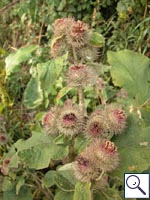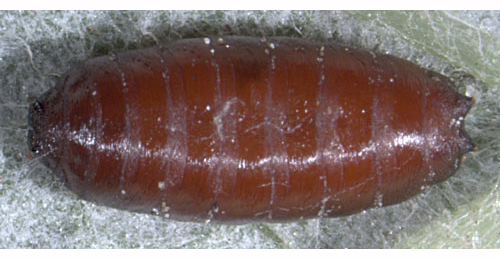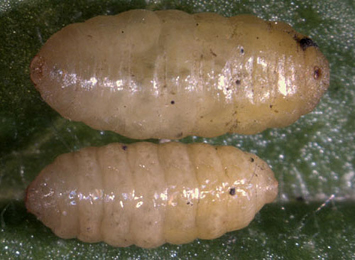|
||||||
|
ARCTIUM. Burdocks. [Asteraceae] |
|
|
Four species of Arctium are recorded in Britain. These include the native species Greater Burdock (A. lappa), Lesser Burdock (A. minus) and Wood Burdock (A. nemorosum). The BSBI provide a downloadable plant crib for Arctium. Fifteen or sixteen British miners are recorded on Arctium. A key to the European miners recorded on Arctium is provided in Bladmineerders van Europa. The agromyzids Liriomyza huidobrensis and Liriomyza trifolii, polyphagous pest species of ornamental and vegetable crops occasionally intercepted at UK points of entry, are recorded on Arctium. Both species have been found under glass in England and Wales. All populations have been and continue to be eradicated. See also Liriomyza species in Glasshouses and/or Quarantine Interceptions. The agromyzid Melanagromyza lappae is recorded boring the stems of Arctium in Britain and elsewhere. |
 Lesser burdock Arctium minus |
Key for the identification of the known mines of British |
Note: Diptera larvae may live in a corridor mine, a corridor-blotch mine, or a blotch mine, but never in a case, a rolled or folded leaf, a tentiform mine or sandwiched between two more or less circular leaf sections in later instars. Pupation never in a cocoon. All mining Diptera larvae are leg-less maggots without a head capsule (see examples). They never have thoracic or abdominal legs. They do not have chewing mouthparts, although they do have a characteristic cephalo-pharyngeal skeleton (see examples), usually visible internally through the body wall. The larvae lie on their sides within the mine and use their pick-like mouthparts to feed on plant tissue. In some corridor miners frass may lie in two rows on alternate sides of the mine. In order to vacate the mine the fully grown larva cuts an exit slit, which is usually semi-circular (see Liriomyza huidobrensis video). The pupa is formed within the hardened last larval skin or puparium and as a result sheaths enclosing head appendages, wings and legs are not visible externally (see examples). See Key to non-Diptera. |
1b > Leaf-miner: A distinctive mine primarily above mid-rib, with irregular short lateral offshoots into leaf blade. Pupation external (Spencer, 1972: 51 (fig. 172), 55; Spencer, 1976: 270, 271 (fig. 486)). Branched, whitish, upper-surface corridor; main axis overlying the midrib; side branches overlying the main lateral veins. (In Campanula and Phyteuma the mine is much less branched, sometimes nothing more than a corridor on top of the midrib). Frass in rather long strings. Usually the mines begins as a long and narrow, shallow, tortuous lower-surface corridor that ends upon the midrib but otherwise is not associated with the leaf venation. Often this initial corridor is filled with callus, and then even less conspicuous. Pupation outside the mine. A linear mine on the upper surface, usually following the midrib and showing side branches along the veins. The frass is in strings. |
|
Liriomyza strigata (Meigen, 1830) [Diptera: Agromyzidae]. |
1b > Leaf-miner: Blotch mine restricted by leaf veins; frass in irregular lumps. The mine begins at the leaf underside, close to a heavy vein, at a white egg shall that remains in place even in fully developed mines. Often several eggs at distances of about 1 cm along the vein. Each larva makes a large blotch without a preceding corridor. Almost all frass is concentrated in a big mass in the the initial part of the mine. In this part the mine is lower-surface (therefore one sees green leaf tissue overlying the frass mass), but further on the mine is upper-surface, in fact almost full depth and very transparant. In fresh mines remnants of the parenchyma are visible as secondary feeding lines. Often the older mines coalesce. Pupation outside the mine. Forms a large blotch mine, which may contain several larvae, on the leaf upper surface. The white eggs are laid close to a vein. |
 Pegomya laticornis puparium Image: © Willem Ellis (Bladmineerders van Europa) |
|
Pegomya laticornis (Fallén, 1825) [Diptera: Anthomyiidae]. |
1c > Leaf-miner: A large blotch, yellow or brown, preceded by a short, in the end mostly unrecognisable corridor. Generally several larvae in the mine. Especially in fresh mines the green primary and feeding lines area well marked. Pupation outside the mine. |
|
Cryptaciura rotundiventris (Fallén, 1814) [Diptera: Tephritidae]. |
1d > Leaf-miner: An upper surface corridor mine, becoming strongly broadened and blotch-like. The mine can occupy a considerable part of a small leaf. Mines frequently merge and then accommodate several larvae. Pupation external, in the soil. Upper-surface corridor, in the end strongly widened and blotchy; may occupy a large portion of smaller leaves. Mines may coalesce, and contain several larvae then. Primary and secondary feeding lines very conspicuous (picture). Pupation outside the mine. Makes upper surface blotches. |
|
Acidia cognata (Wiedemann, 1817) [Diptera: Tephritidae]. |
1e > Leaf-miner: Full depth, initially a much branched corridor, irregular in width, in the end almost a blotch. The mine has openings by which part of the frass is ejected. The larvae frequently leave the mine to restart elsewhere. Older larva live free and cause window feeding, often erasing their old mines. In Coltsfoot also pseudo-mines are made, when the larva eats away the lower epidermis with the leaf tissue, but spares the dense hair cover. |
|
Phytosciara halterata Lengersdorf, 1926 [Diptera: Sciaridae]. |
1f > Leaf-miner: The mine begins as a long, quite narrow corridor, usually not far from the tip of a leaf segment. Usually this corridor follows the leaf margin for some distance, but it may also run freely through the blade and may then be stongly contorted. In the end the corridor is directed towards the midrib, where an elongated blotch is formed, overlying the midrib and some of the larger lateral veins. Frass in a nearly continuous line in the initial corridor, in scattered lumps in the later part of the mine. Primary and secondary feeding lines very conspicuous when seen in transparancy. Pupation outside the mine. The mine starts as a very narrow corridor, usually close to the tip of a leaf segment and following the leaf margin. The later section of the corridor approaches the main vein, where an elongated blotch is made with long broad finger like extensions that lay over the secondary veins. In the initial corridor the frass forms an almost continuous line, in the blotch it is distributed in large scattered lumps. In fresh mines the secondary feeding lines are clearly visible. |
|
Trypeta zoe Meigen, 1826 [Diptera: Tephritidae]. |
1g > Leaf-miner: A large blotch, yellow or brown, preceded by a short corridor that in the end mostly is completely overrun. Generally several larvae share a mine. Especially in fresh mines the green primary and secondary feeding lines are well visible. Pupation outside the mine. Hering (1957a) warns that the mines cannot be separated from those of the rare Cryptaciura rotundiventris. Mine is deep and leads to a blotch, which is usually coloured yellow or brown (British leafminers) |
 Euleia heraclei pupariria Image: © Willem Ellis (Bladmineerders van Europa) |
|
Euleia heraclei (Linnaeus, 1758) [Diptera: Tephritidae]. |
1h > Leaf-miner: Linear, corridor mine. |
2a > Leaf-miner: Mine linear, whitish, both upper and lower surface. Pupation internal, at the end of the mine with the anterior spiracles projecting through the epidermis (Spencer, 1976: 433). Upper-surface, less often lower-surface corridor. Frass in isolated grains. Pupation within the mine, usually in a lower-surface puparial chamber. A long whitish upper surface corridor, which eventually goes lower surface. |
|
Chromatomyia
horticola (Goureau, 1851) [Diptera: Agromyzidae] |
2b > Leaf-miner: An unusually long, narrow, whitish linear mine, frequently following a vein. Numerous larvae can occur together in a single leaf which can be completely eaten out. Pupation external (Spencer, 1972b: 74 (fig. 247); Spencer, 1976: 438, 439 (fig. 766)). Long, little widening corridor. The first part is contorted, and its very first stretch is lower-surface; all other parts are upper-surface. The lower-surface part is visible as a light patch when illuminated from behind. The corridor often looks rather angular, because it tends to follow a vein over a considerable distance. Frass in rather large, well-spaced grains, often deposited at the same side of the corridor for a considerable length. Often several mines in leaf, that may seem white then when seen from a distance. Pupation outside the mine; exit slit in upper epidermis. A very long, white, upper surface gallery which follows the veins and can appear angular because of this. Usually several in one leaf. |
|
Phytomyza lappae Goureau, 1851 [Diptera: Agromyzidae]. |
2c > Leaf-miner: Larva feeds along the mid-rib, predominantly on the lower surface and there is little evidence of gall-like swelling. Pupation takes place at the base of the midrib (Spencer, 1976: 496). |
|
Phytomyza continua Hendel, 1920 [Diptera: Agromyzidae]. |
|
Key for the identification of the known mines of British |
Note: The larvae of mining Coleoptera, Hymenoptera and Lepidoptera may live in a corridor mine, a corridor-blotch mine, a blotch mine, a case, a rolled or folded leaf, a tentiform mine or sandwiched between two more or less circular leaf sections in later instars. Larva may pupate in a silk cocoon. The larva may have six legs (although they may be reduced or absent), a head capsule and chewing mouthparts with opposable mandibles (see video of a gracillarid larva feeding). Larvae of Hymenoptera and Lepidoptera usually also have abdominal legs (see examples). Frass, if present, never in two rows. Unless feeding externally from within a case the larva usually vacates the mine by chewing an exit hole. Pupa with visible head appendages, wings and legs which lie in sheaths (see examples). |
1a > Leaf-miner and case-bearer: The larva lives outside the mine, protected by a case, and feeds on the underlying plant tissues via a hole cut in the epidermis. From that point it eats away as much leaf tissue as it can reach without fully entering the mine. Mine does not contain frass (Coleophora species) |
| 2 |
1b > Leaf-miner, but not a case-bearer: The larva lives mainly inside the mine. Mine usually contains frass. In later instars the larva may live sandwiched between two more or less circular sections cut from the leaf. |
2a > Leaf miner and case-bearer: Larva mines leaves. The larva builds a case from silk, resembling a razor shell in appearance.. The full-grown case is 12 mm long and blackish-brown. The full grown larva lives in a blackish brown trivalved tubular silken case of about 8 mm. The mouth angle is 0°-10°, causing the case to lay almost flat on the leaf. |
|
Coleophora paripennella Zeller, 1839 [Lepidoptera: Coleophoridae]. |
2b > Leaf miner and case-bearer: The larva forms a case, approximately 11-12 mm long, beneath a thistle leaf, although burdock may sometimes be used. The shape of the ochreous case varies as, when being enlarged, it is elongated first, and the girth increased subsequently. Yellow-brown to light grey tubular silken case with darker length lines. The case is fairly large (up to 17 mm) and very slender. The rear end is three-valved, the mouth angle about 50°. The larva feeds at the underside of the leaf. |
|
Coleophora peribenanderi Toll, 1943 [Lepidoptera: Coleophoridae]. |
3a > Leaf-miner: The eggs of this species are laid on a leaf, with the larvae mining the underside of the leaf, until a late instar when it feeds in a web under the midrib of the leaf, causing visible blotching on the upperside. Short, full depth corridor. The larva relatively long lives as a miner, but finally leaves the mine and continues living in spinning along the midrib at the leaf underside, from where windows are eaten in the leaf. |
 Mines of Agonopterix propinquella on Cirsium arvense Image: © Ian Smith (UKMoths) |
|
Agonopterix propinquella (Treitschke, 1835) [Lepidoptera: Depressariidae]. |
3b > Leaf-miner: In the first instar the larva mines the leaves, forming short, irregular, blotch-like mines, but in later instars it lives externally, feeding in spun leaves and often twisting those of tender shoots. Larval head light-brown or yellowish brown, edged with black postero-laterally, ocellar area blackish; prothoracic plate black edged with whitish anteriorly; abdomen dull dark green; pinacula distinct, black, sometimes brownish but with black bases to setae; anal plate large, black (Bradley et al., 1973). Small, full depth mine without a definite shape; little frass. Some silk is deposited in the mine. The larva soon leaves the mine and continues feeding among spun leaves. |
|
Cnephasia incertana (Treitschke, 1835) [Lepidoptera: Tortricidae]. |
3c > Long corridor, often following the leaf margin, with little frass and with the sides irrregularly eaten out. The first part of the corridor is full depth and makes a few close loops; the later part is more upper-surface and rather wide. Primary feeding lines often conspicuous. No morphological differences are known between the larva of S. rubidum and S. testaceum (Steinhausen, 1994a). However, there is a phenological difference: the larva of testaceum hibernates in the mine and continues feeding after winter; S. rubidum vacates the mine before winter and pupates in the soil. Hering (1957a) suggests that the identification of the beetles is an easy matter, but that is contradicted by Warchalowski (2003a). |
|
Sphaeroderma testaceum (Fabricius, 1775) [Coloeptera : Chrysomelidae]. |
3d >Long corridor mine, without obvious relation with the leaf margin, with little frass and irregularly eaten out sides. The first part of the mine is full depth and makes a few close loops; the second part is upper-surface and considerably wider. Primary feedings lines often obvious. The larva is so broad that is completely fills the mine. No morphological differences are known between the larvae of S. rubidum and those of S. testaceum (Steinhausen, 1994a). The larva leaves the mine to pupate in the soil (the larva of testaceum hibernates in the mine.) Hering (1957a) suggests that the imagines are easily separated, but this is contradicted by Warchalowski (2003a). |
|
Sphaeroderma rubidum (Graells, 1858) [Coloeptera : Chrysomelidae]. |
| Last updated 30-Jun-2019 Brian Pitkin | ||
